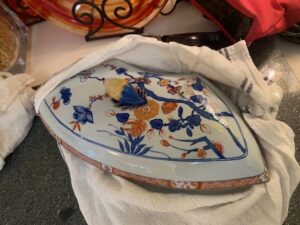 JE sent me photos of two pieces of a five-piece set of Copeland-Spode covered dishes circa 1900. Both the style and the form of the dishes point to the late 19th to early 20th century, the British EDWARDIAN period, so beloved of period drama shows.
JE sent me photos of two pieces of a five-piece set of Copeland-Spode covered dishes circa 1900. Both the style and the form of the dishes point to the late 19th to early 20th century, the British EDWARDIAN period, so beloved of period drama shows.
Four covered dishes and one central tureen, a Canterbury, rotated on a lazy susan on the sideboard of a 1900 English country manor’s breakfast room. Servants filled these dishes and set them out at 9 am along with silvered chafing dishes and other covered serving pieces. Aristocratic diners served themselves from that antique mahogany sideboard dating from the 18th century, the Georgian period. A separate side table held hot drink urns and dishes requiring braziers. Guests of the house brought their full plates from the sideboard to the breakfast table around 9.30 am. Servants weren’t expected to emerge until after breakfast.
At breakfast people discussed events of the day to come, outdoor activities such as the hunt, tennis, or croquet. So they thought it acceptable to show up for breakfast in sport clothes. In 1905-1912 hunting was popular on the country estates. By the 1920s, because of the international flavor of WWI, the world became a bigger place gastronomically speaking. French omelets joined the rich game served at breakfast.
Spode Held Flavors of the Era
Delicacies each of the five pieces contained indicate a flavor of the era. The type of entrees, popular among the wealthy in England in 1900, represent the beginning of the famous English “fry-up.” Anyone who stayed in a bed and breakfast in England with a “full” 9-10 am breakfast will find them familiar.
In 1900 the Canterbury contained any one of these: bacon, black pudding, sausage, baked beans, grilled tomatoes, kedgeree (haddock), kippers, cold joints, potted fish, cold game or ham, veal and ham pie, game and rump steak pie, tongue, muttonchops, rump steak, broiled sheep’s kidneys, bread fried in drippings or goose fat, Galantines, cold grouse, cold pheasant, cold ptarmigan, whiting fish, devilled kidneys, or fish in shells.
They ate porridge wherever they stood. Sir Harold Nicolson, (1886-1968), a member of the Edwardian aristocracy, a premier British diplomat and former member of the House of Parliament, wrote about the English Manor House breakfast in his book Small Talk: “In the archetypal country house breakfast, porridge was eaten negligently by people walking about the breakfast room and watching the rain descend upon the Italian style garden outside the windows after the many main courses.” Insouciance comes to mind….
The Proper Way to Entertain
Late Victorian females, such as Isabella Beaton, published recipe books on the proper English way to entertain. Luncheon was served formally at 1 pm, presented on the sideboard or served by the staff. Formal tea happened at 5 pm with sweet buns, then the gong went off at 6.30 indicating time to dress for dinner, then cocktails at 7. A formal English style dinner took place at 8pm.
Reading the list of what Edwardians ate for breakfast from the Canterbury set, I wager they were LARGE people. To eat this way at breakfast packed on the pounds. However, historians of this style of eating opine the inhabitants of the drafty ancient country homes needed to consume calories because of NO central heating. Plus 1900 England was colder than today.
Makers of the Canterbury, Copeland Spode, established a English crockery business as far back as 1700 when the main ingredient for porcelain was discovered in Cornwall. By 1880 English ceramic factories added ground animal bones to the slurry for stronger porcelain, hence the birth of BONE china. Josiah Spode went from apprentice in 1754 to owner of a ceramic factory in 1776. He modernized his factory by introducing mechanical pottery tables and transfer printing on china. They no longer needed to hand-paint porcelain. He opened a shop for the aristocratic buyer in London in 1788, employing William Copeland, as enterprising as Spode, buying Spode’s business in the mid-19th century.
The Canterbury was made in 1900 under both names. The value of the set is $600 because it’s complete after 125 years. We don’t eat what it held in 1900, however!